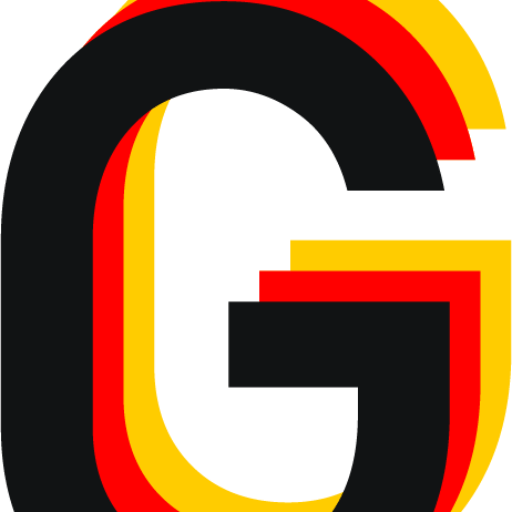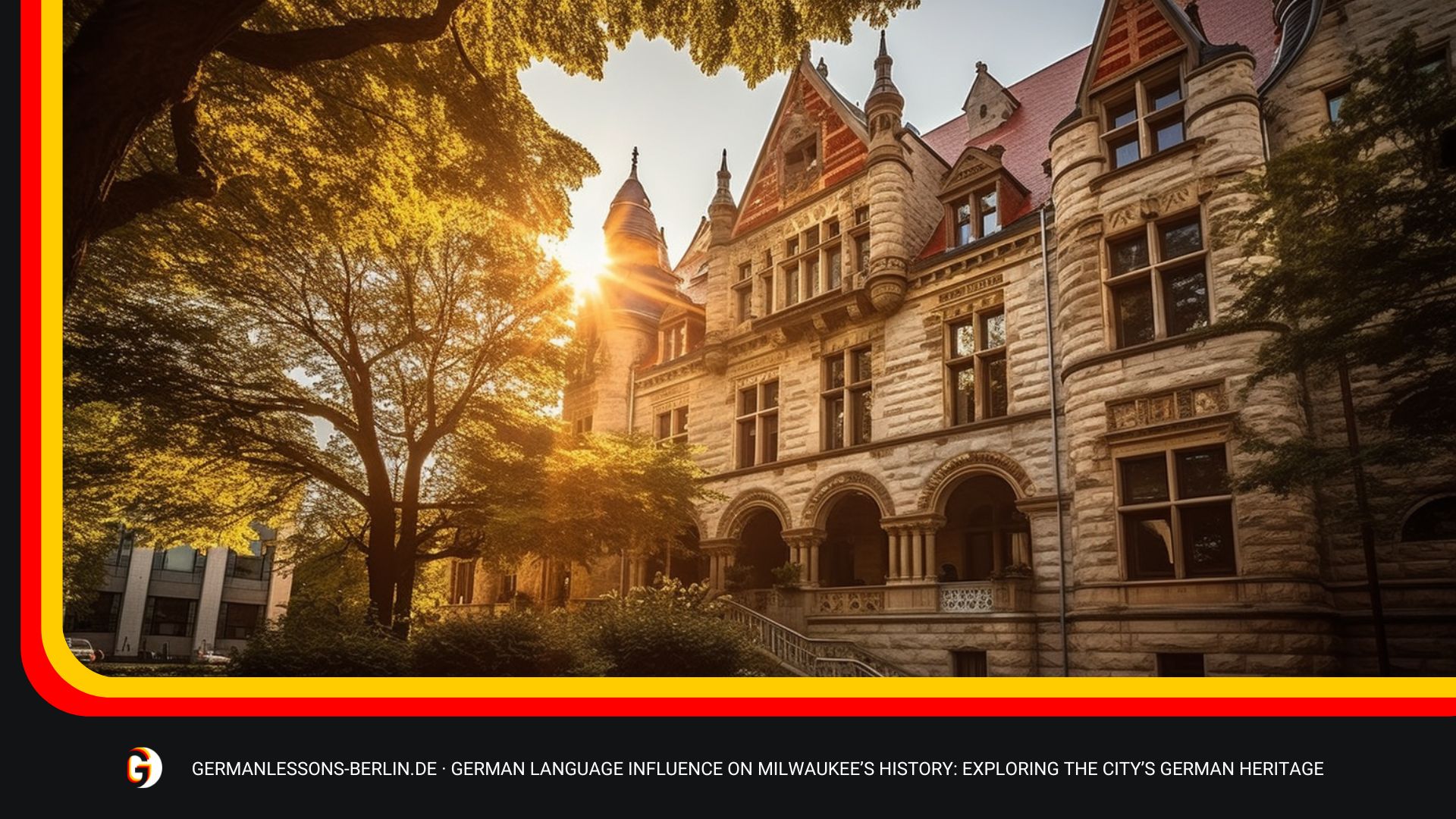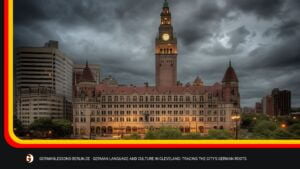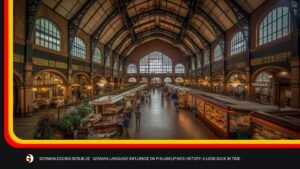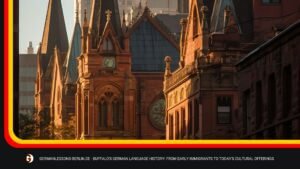Have you ever wondered how the German language influences Milwaukee’s history? This city is full of unique culture, which includes a solid connection to its German heritage. From the architecture to the cuisine and popular activities, it’s easy to see that this Midwestern metropolis has been heavily influenced by its past generations of immigrants from Germany. In this article, we will explore what makes Milwaukee so unique and discover how the legacy of the German language continues to shape it today.
From beer gardens and bratwurst to old-world churches and festivals, Milwaukee offers many reminders of its German roots. Even though most people no longer speak the language, they still celebrate traditions such as Oktoberfest in honor of their ancestors who came here looking for a better life. These celebrations are just one way Germans have left an indelible mark on the city’s identity over the years.
The influence of the German language in Milwaukee isn’t limited to festivities either – there are also signs everywhere throughout town! Streets with names like Kaul Avenue or Berger Street hint at places where early settlers might have lived or worked; meanwhile, business names like Miller Brewing Co., Schlitz Brewery, and Usinger Sausage reflect thriving companies founded by German immigrants more than 100 years ago. We’ll take a closer look at all these pieces of evidence showing how much impact the German language had on Milwaukee’s development.
Table of Contents
Milwaukee’s German Settlers
Milwaukee’s German heritage runs deep. Since the city’s earliest days, German settlers have been a crucial part of its history and identity. When Milwaukee was founded in 1846, nearly half of all its residents were immigrants from Germany.
These early German migrants arrived in Milwaukee seeking opportunities for work and a better life. They found both in this bustling port city along Lake Michigan, where they could find employment or start their businesses. Many Germans also sought out the community existing here among other German settlers who had come before them. This sense of camaraderie helped these new arrivals to feel at home as soon as they arrived in Milwaukee.
More than 120 years later, many traces of German culture remain throughout Milwaukee – from the neighborhoods named after prominent figures from Germany to the iconic local dishes like bratwurst and sauerkraut that are still served today. These reminders help to honor those who first came here in search of a better life and remind us all why we should never forget our roots.
German Immigrant Communities
Having explored the history of Milwaukee’s German settlers, it is time to take a closer look at the immigrant communities that have grown and developed in Milwaukee over time. These German-immigrant communities have left an indelible mark on Milwaukee’s culture and identity, as they brought their customs and traditions.
The German immigrants who first arrived in Milwaukee settled primarily around what is now known as the “German Triangle,” located between North Avenue, Wells Street, and 4th Street. This area was home to many different types of Germans from various parts of Germany, including Prussia, Bavaria, Hesse, and Saxony. Many were attracted by the city’s industrial development and found jobs in factories or farms nearby. Over time, these early German immigrants built churches and clubs for social activities, such as singing societies called Liederkranzs. While some moved out into other areas of the city as new job opportunities arose elsewhere, many stayed within this neighborhood, creating a unique community distinct from other ethnic neighborhoods in Milwaukee.
These German-immigrant communities enriched life in Milwaukee and contributed significantly to its development through their entrepreneurial spirit. In addition to establishing businesses ranging from breweries and bakeries to banks and insurance companies, they also played vital roles in local and national politics when Wisconsin was still considered part of the Midwest frontier. As a result of their significant contributions over generations, traces of their presence remain today—from landmarks such as The Pfister Hotel (built-in 1893) to culinary classics like bratwurst—and serve as reminders of Milwaukee’s vibrant past and how deeply rooted it is in its German heritage.
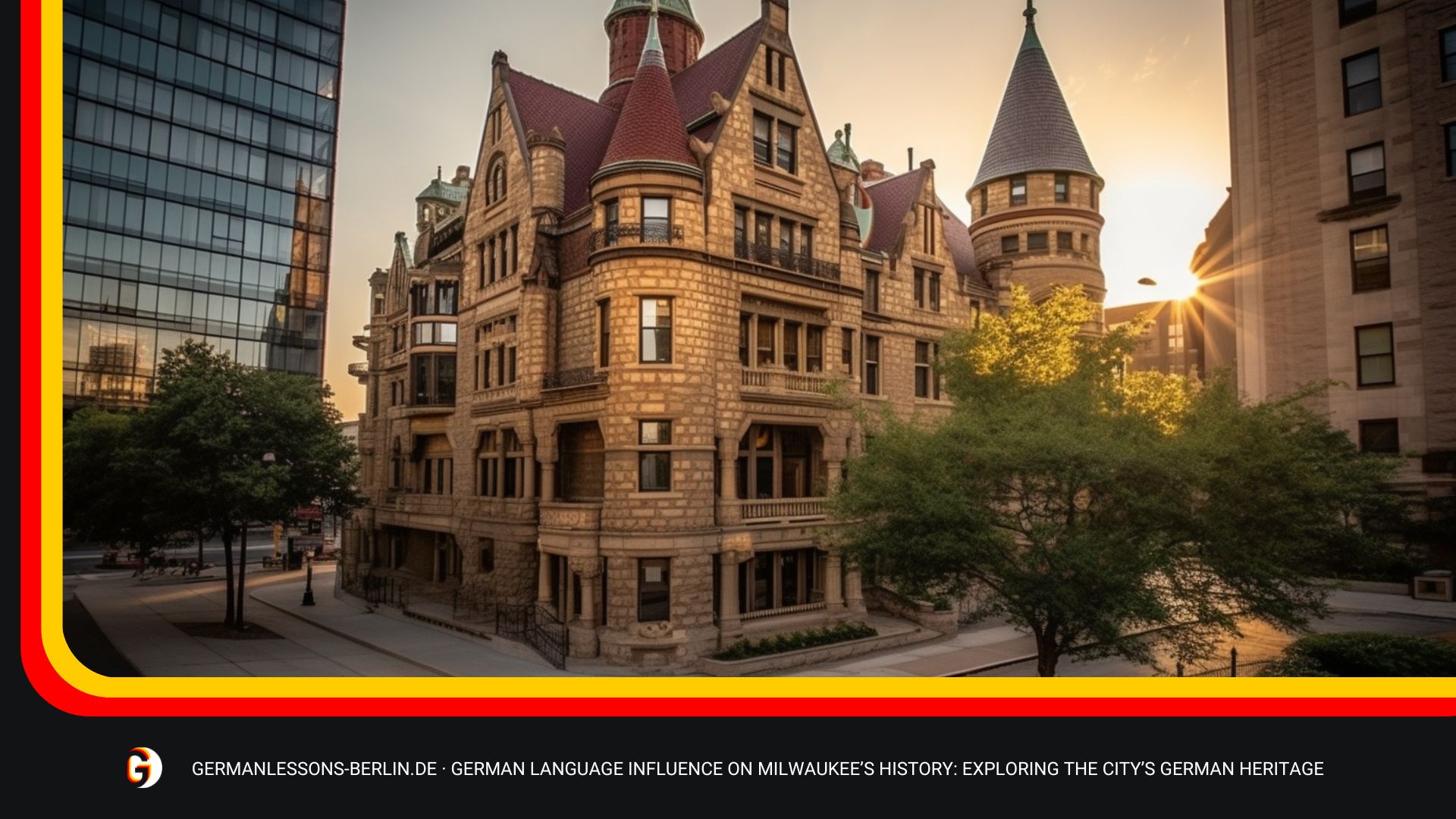
German-American Cultural Influences
German Americans have had a profound and lasting influence on the culture of Milwaukee. German-American music has been an integral part of the city’s history since its founding in 1846, with many traditional songs still being sung today. The distinct German-American style is evident in the city’s various art galleries and local festivals that celebrate this unique cultural heritage.
German-American literature also has a strong presence in Milwaukee, from classic works such as Goethe’s Faust to modern stories written by contemporary authors like Konrad Reiser. This literary tradition helps keep alive language and ideas that originated in Germany hundreds of years ago. Furthermore, it serves to remind us how much these immigrant communities have contributed to our collective identity over time.
Food plays a vital role in both preserving and expressing German-American culture. From bratwursts to sauerkraut, numerous dishes prove this community’s deeply rooted within Milwaukee’s culinary scene. Even more importantly, they serve as reminders of all those who came before us and their contributions to our shared future. With each bite we take, we can honor their legacy and ensure it lives on for generations to come.
From music and art to food and literature – German-Americans continue to shape the culture of Milwaukee every day, leaving behind a vibrant tapestry that celebrates diversity while simultaneously connecting us all as one people united by common ancestry and shared values.
Preservation Of The German Language And Culture
The German language has been an integral part of Milwaukee’s heritage for centuries, and its influence can be seen in many aspects of the city’s culture today. To preserve this important cultural legacy, local organizations are working hard to ensure that the German language is kept alive and accessible. Here are some ways they’re doing it:
- Teaching German Language Classes: Local organizations have developed classes on learning German to help keep it alive. These classes range from beginners’ courses to more advanced tutoring sessions, giving people of all ages a chance to learn how to speak and understand German.
- Promoting Heritage Festivals: Milwaukee hosts yearly festivals celebrating its rich German heritage – such as Oktoberfest or Summer Soulstice – which bring together locals who share a passion for their shared history and culture. At these events, participants can sample traditional cuisine while listening to live musical performances by bands playing authentic folk music from Germany.
- Supporting Community Programs: Organizations like “German Americans United” offer educational programs that focus on teaching children about their ancestral roots through activities like cooking dishes native to Germany or studying different customs related to life there. This helps young people appreciate the value of preserving their family’s cultural heritage even if they don’t speak the language themselves. By investing in these initiatives, Milwaukee ensures its strong connection with its German past remains intact for generations. Through efforts like these, current and future citizens will continue to have access to resources that honor and celebrate their ancestors’ contributions.
Educational Institutions Promoting The German Language
Milwaukee is a city with a rich German heritage, which can be seen in the many educational institutions promoting the German language. From schools offering classes to centers dedicated to learning, there are numerous opportunities for those interested in furthering their knowledge of Germany’s native tongue.
German-language schools have been around for generations, providing formal instruction on grammar, pronunciation, and culture. Milwaukee has several such institutions which offer courses at all levels, from beginner to advanced. Many also provide additional activities such as field trips or cultural events so students can gain an even greater appreciation of the language and its history.
The city also boasts several independent organizations devoted to German-language learning. These range from informal conversation groups to more structured programs like weekly classes or seminars. Whatever your level of proficiency, these centers provide an excellent opportunity to practice and hone your skills while making new friends along the way.
Whether you’re looking for a formal education in German or want to brush up on some basics, Milwaukee has plenty of options available for anyone seeking a connection with its proud German heritage through studying its language.
German-Language Publications In Milwaukee
The city of Milwaukee has a long history of German-language publications, which have played an essential role in preserving the culture and language of its German immigrant population. From newspapers to magazines, these publications offer insight into the lives and experiences of those who settled in this part of Wisconsin.
Der Nord Westen (“The North West”) was one such publication. Founded in 1844 by three brothers from Germany—Johannes, William, and Franz Gieseke—Der Nord Westen served as a source for news about events around the world and a platform for political discussions about issues relevant to Germans living abroad. It ran for nearly 75 years before ceasing operations due to financial problems in 1918. During that time, it became one of the most widely read German-language papers outside Germany.
Another influential German-language newspaper was The Milwaukee Herold (“The Milwaukee Herald”), founded by Christian Reissig in 1851. Like Der Nord Westen, The Milwaukee Herold provided news from Europe alongside local content relevant to Germans living in or near Milwaukee. In addition to regular politics and current affairs features, it also published stories about entertainment, sports, health care advice, religious topics, travel tips, and more.
These two newspapers were just two examples of many German-language publications throughout Milwaukee’s history. Other titles included Die Volkszeitung (“The People’s Newspaper”), Das Tagblatt des Mittwests (“Daily Paper of Midwest”), and Der Freie Demokrat (“Free Democrat”). These pieces helped connect immigrants with their home countries and fostered a sense of belonging within their new communities here in America.
| Publication | Date Started | Founder(s) |
|---|---|---|
| Der Nord Westen | 1844 | Gieseke Bros |
| The Milwaukee Herold | 1851 | C. Reissig |
Festivals Celebrating German Heritage
Milwaukee is proud of its German heritage and celebrates it through various festivals. The city’s most prominent festival is the Milwaukee Germanfest, which takes place every summer in June at Maier Festival Park on Lake Michigan. It is a three-day event that features live music, traditional Bavarian dancing, authentic German food, beer gardens, and other activities.
The city also hosts Oktoberfest each year. This two-week-long celebration includes numerous events, such as an outdoor Biergarten where attendees can sample different varieties of beers from local breweries, polka dance competitions, bratwurst eating contests, and more. In addition to these popular celebrations of German culture, there are several smaller festivals held throughout the year, including:
- Heritage Days – Held annually in August near Cathedral Square Park, this two-day event includes various family activities such as carnival rides and games, folk dancers performing traditional dances from Germany and Central Europe, and plenty of delicious foods like schnitzel sandwiches and strudels.
- German-American Festival – A one-day event hosted by the local chapter of the American Historical Society every September; it features performances by local bands playing polka music, traditional German crafts for sale, homemade sauerkraut dishes prepared by members of the community, and many other festivities.
- Deutsch-Amerikaner Fest – An annual festival celebrated in October at the Glendale Town Hall Courtyard; it showcases classic car shows with vintage cars from around Germany and exhibits showcasing historical artifacts related to early settlers who arrived in Wisconsin during the 19th century.
These festivals help keep Milwaukee’s rich cultural history alive while providing entertainment for all ages. From sampling unique cuisine to enjoying live music performances—attendees get a taste of what life was like when Germans first immigrated here centuries ago. Whether you’re looking to experience something new or want to reconnect with your roots—these days provide an opportunity to do both!
Local Businesses Reflecting German Influence
The German influence on Milwaukee’s culture is evident in its local businesses. From german-style restaurants to breweries and pubs, bakeries, and markets – all reflect the city’s rich heritage.
Take, for instance, the many german-style restaurants throughout the city that specialize in traditional dishes like schnitzel, sauerbraten, bratwurst, and spaetzle. These eateries provide patrons with a taste of Germany right here at home. Furthermore, there are also several German-style breweries scattered across town where beer lovers can sample unique craft brews inspired by centuries-old recipes from the Old Country.
The same goes for german-style pubs, bakeries, and markets as well. Pubs serve classic favorites such as weissbier (wheat beer), while bakeries feature a variety of pastries, including apple strudel and pretzels. Finally, markets offer not only imported German delicacies but also products made locally using age-old techniques like charcuterie making or artisanal cheese production.
Milwaukee businesses have embraced their German roots by providing customers with an impressive array of options when it comes to experience authentic German cuisine and culture without ever having to leave home.
Popular Cuisine With A German Twist
Moving forward from how German influence has been reflected in Milwaukee’s businesses, it’s also evident in the city’s famous cuisine. Many restaurants feature classic German-style sausages and sides and a variety of German-style beers on tap. These dishes are staples for any fan of traditional Bavarian flavors, offering local favorites such as bratwurst and some less common specialties like knackwurst or blutwurst.
In addition to these main courses, those seeking more subtle hints of Germany can find them in several different desserts and snacks. From German-style pretzels to Black Forest cake, there is something for everyone when it comes to sweet treats influenced by this culture. Not only do they provide an opportunity to sample authentic recipes passed down through generations, but they also offer a delicious way to experience the unique flavor combinations found in many classic German recipes.
Eating out at one of Milwaukee’s numerous German-style restaurants is another excellent option for visitors looking for a truly immersive experience of its history and heritage. Here you’ll be able to enjoy hearty portions of classic dishes while sipping on some traditional beer served up stein style—all set against the backdrop of live music and cheerful conversation among friends old and new alike. It’s no wonder why so many locals flock here time after time: it offers a taste of food and the community!
Modern Reflections Of Milwaukee’s Rich German Heritage
Milwaukee is known for its rich German heritage, and this influence can still be seen today. Throughout the city, there are numerous german-american restaurants that celebrate Milwaukee’s unique culture through traditional dishes. These eateries serve up delicious german-inspired cuisine that has become a staple of the city’s culinary landscape. Visitors to these establishments often remark on how well they capture the spirit of Germany in their menu items.
In addition to german-american restaurants, Milwaukee hosts many festivals throughout the year dedicated to celebrating its rich history. During Oktoberfest, locals don dirndls and lederhosen while indulging in classic Bavarian treats like pretzels and bratwurst. Other events, such as Maifest and Volksplatz celebrate German music, dance, art, and more with performances from local musicians and artists.
These modern reflections of Milwaukee’s German heritage help keep alive a critical part of the city’s past while introducing it to new generations of visitors who come to experience all it has to offer. From sauerkraut and beer gardens to polka bands and folk dancers, you’ll find no shortage of ways to explore Milwaukee’s vibrant German culture here today!
Frequently Asked Questions
How Did German Immigrants Impact The Economy In Milwaukee?
The influx of German immigrants to Milwaukee profoundly impacted the city’s economy. The economic influence was felt in many ways, from cultural contributions to increased business opportunities for new arrivals. This article will explore how German immigrants shaped the economy of Milwaukee and what their lasting legacy remains today.
German culture brought an array of industries that would benefit newcomers and local businesses alike. In addition to traditional immigrant occupations such as brewing beer or baking bread, some German-owned factories began manufacturing goods like clocks and tools:
– Beer Brewing
– Baking Bread
– Manufacturing Clocks & Tools
– Selling Cheese
These products provided employment opportunities and helped boost consumer spending in the local economy, making it easier for people to purchase these items at lower costs than they could find elsewhere in America. Moreover, this allowed more people access to necessary goods like food, which further benefited the community by providing sustenance and stability during difficult times.
In addition to direct economic impacts, German culture left an indelible imprint on the city through its religious institutions, language schools, musical gatherings, and other forms of entertainment. These social activities created a sense of belonging among immigrants who were often far away from home and gave them something familiar in a strange land where familiarity can be hard to come by. Furthermore, this added another layer of diversity to Milwaukee’s already vibrant mix of cultures, making it one of Wisconsin’s most culturally diverse cities.
Today, there is still evidence of German influence around town – from modern-day Oktoberfests held every year attracting thousands of attendees to restaurants serving up classic dishes like bratwurst and sauerkraut; all reminders that over time generations pass down stories while preserving traditions along the way that keep communities connected no matter where they are located geographically or historically speaking.
What Are The Most Popular German Words Used In Milwaukee Today?
Regarding Milwaukee, one of the most popular questions is, what are some German words used today? Undeniably, many people in Milwaukee have embraced their city’s rich German heritage and still use these words daily. From simple slang terms to more obscure phrases, many famous German words are commonly found throughout the city.
To explore this further, take a look at some of the top German words used in Milwaukee: Kaffee (coffee), Bratwurst (bratwurst sausage), Biergarten (beer garden), Wissenschaft (science), and Schmeckt Gut! (it tastes good!). These standard terms reflect the German language’s strong influence on both culture and lifestyle in Milwaukee for centuries.
Additionally, numerous other German-language words can be heard among locals when conversing or visiting local establishments such as restaurants and pubs. From “Guten Tag” (Good Day!) to “Auf Wiedersehen” (goodbye!), visitors will find themselves surrounded by familiar-sounding phrases while exploring the streets of Milwaukee. Furthermore, evidence suggests that many modern-day American expressions may have originated from old-world German dialects spoken in this very same city!
It’s remarkable how much impact the German language has had on Milwaukee history – not just through its traditional customs but also through its unique speech patterns, which continue to shape life in this vibrant metropolis even today.
How Did German Immigrants Shape Milwaukee’s Political Landscape?
When considering how German immigrants have shaped Milwaukee’s political landscape, it is essential to consider their influence on the city’s history. German immigrants have left a lasting impact on the politics of Milwaukee, which can be seen in many aspects of its past. From voting patterns to cultural organizations, there is no doubt that these people have immensely affected the city’s development.
Voting patterns are the most obvious example of German influence in Milwaukee’s political landscape. Germans were among some of the earliest settlers to Wisconsin; as such, they established strong bonds with other ethnic groups within the state and even beyond it. This led them to form powerful coalitions that often determined election outcomes for years after their establishment. It was not uncommon for two or more different political parties to join together due to similar sentiments amongst members from both sides; this allowed them to become influential figures in determining official policy decisions throughout Milwaukee’s history.
Furthermore, numerous cultural organizations founded by German immigrants still exist today and continue to play a role in shaping local politics. These include everything from churches and fraternal organizations to schools explicitly dedicated to educating young students about their heritage. Additionally, many festivals are held yearly to celebrate Germany’s rich culture and traditions; these events draw large crowds from all over the country who come out to enjoy traditional music, food, drinks, dance performances, and more. All of these things combine to create an atmosphere where those with German roots can feel connected while also actively contributing positively towards Milwaukee’s current political climate.
It is clear that without German immigrants, much of what we now associate with Milwaukee would likely never have existed – including its vibrant political scene. Their legacy continues through various avenues, including laws enacted that reflect their values along with ongoing efforts made by citizens whose ancestors hail from Germany itself, all of which serve as evidence that they genuinely did shape Milwaukee’s political landscape significantly during their time here and will continue doing so indefinitely into the future.
What Is The Best Way To Learn The German Language Today?
Learning a new language can be daunting, but the German language is exciting and enjoyable to remember. It has its roots in many parts of Europe and is spoken by millions worldwide today. But what is the best way for someone interested in learning this rich language?
Fortunately, plenty of options are available when it comes to learning the German language. From online courses to physical classes held at universities and community centers, learners have access to many different sources that can help them become proficient speakers. For those looking for more intensive instruction, there are also private tutors who specialize in teaching German grammar and vocabulary. In Milwaukee specifically, several local institutions offer classes or other resources for students wanting to learn this fascinating language.
Whatever method you choose, dedicating yourself to mastering the German language will bring great rewards. The knowledge gained from studying German culture and its literature and history will open up academic and professional doors. With plenty of opportunities for practice through reading books, watching movies, and even having conversations with native speakers, anyone willing to put in the effort will soon find themselves speaking confidently in no time!
How Has German Culture Been Integrated Into Milwaukee’s Music Scene?
Milwaukee’s rich history of German culture has greatly influenced its musical heritage. Music plays an essential role in preserving and celebrating Milwaukee’s German heritage. By exploring how German music has been integrated into the local music scene, we can better understand German culture’s influence on Milwaukee throughout its history.
German music has always played an integral part in Milwaukee’s cultural landscape, from traditional folk songs to modern interpretations of classic pieces. The city hosts festivals celebrating all aspects of German music and culture, such as Oktoberfest and Der Biergarten Volksmusik Fest (the Beer Garden Folk Music Festival). These events are attended by thousands of people each year who come together to celebrate their shared love for the unique genre of music known as “Deutschland Musik.” Additionally, many local bars feature live performances of traditional german tunes or even entire bands playing covers of famous german hits.
In recent years, there has been a renewed interest in integrating more elements of Germany’s musical traditions into the Milwaukee music scene. Local artists have begun incorporating sounds inspired by traditional german instruments like accordions and oompah horns into their original compositions. Others have gone so far as to form ensembles made up entirely of musicians who specialize in performing authentic renditions of beloved german classics. With this resurgence in popularity comes opportunities for individuals looking to learn more about Germany’s musical heritage – whether it be through attending concerts featuring these groups or taking classes offered at various schools around town that teach students how to play popular german songs on instruments like mandolins and tubas.
No matter what one’s level of expertise may be in Deutschland Musik, there is no denying that it remains an essential part of life here in Milwaukee. From festivals honoring centuries-old customs to contemporary takes on classic melodies, the integration of German musical influences into the city’s vibrant music scene serves not only as a reminder but also provides evidence for just how deeply embedded these traditions continue to remain within our community today.
Conclusion
In conclusion, the influence of German immigrants on Milwaukee’s history has been immense. They have left an indelible mark that is still felt today in the city’s economy and politics. From famous words like “Kindergarten” to a vibrant music scene heavily influenced by traditional German sounds, it is clear how much of an impact these settlers had on the city.
To this day, there are many ways for people to understand Milwaukee’s rich German heritage better. Learning the language can be a great way to experience its culture firsthand and explore all the unique aspects of its history that make it so special. Online courses, tutorials, and even trips abroad are just some examples of ways one could pursue such knowledge.
Ultimately, learning about Milwaukee’s past through its German influences provides insight into our present-day society and helps build bridges between cultures. It teaches us about our identity and encourages curiosity and exploration – something we should all strive for!
Many valuable resources are available online for those interested in exploring the German language’s influence on Milwaukee’s history. The Wisconsin Historical Society, the Milwaukee County Historical Society, the Max Kade Institute for German-American Studies all offer insights into Milwaukee’s rich cultural history, from the early years of German immigration to the present day.
